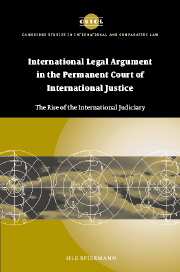 International Legal Argument in the Permanent Court of International Justice
International Legal Argument in the Permanent Court of International Justice Book contents
- Frontmatter
- Contents
- Foreword
- Acknowledgments
- Table of cases
- Table of treaties
- List of abbreviations
- Part 1 The Permanent Court of International Justice
- Part 2 International legal argument
- 2 The basis of international law
- 3 The double structure of international legal argument
- Part 3 International legal argument in the Permanent Court of International Justice
- Part 4 General conclusions
- Appendix: List of Advisory Opinions, Judgments and Orders of the Permanent Court of International Justice
- Bibliography
- Index
- CAMBRIDGE STUDIES IN INTERNATIONAL AND COMPARATIVE LAW
3 - The double structure of international legal argument
Published online by Cambridge University Press: 17 July 2009
- Frontmatter
- Contents
- Foreword
- Acknowledgments
- Table of cases
- Table of treaties
- List of abbreviations
- Part 1 The Permanent Court of International Justice
- Part 2 International legal argument
- 2 The basis of international law
- 3 The double structure of international legal argument
- Part 3 International legal argument in the Permanent Court of International Justice
- Part 4 General conclusions
- Appendix: List of Advisory Opinions, Judgments and Orders of the Permanent Court of International Justice
- Bibliography
- Index
- CAMBRIDGE STUDIES IN INTERNATIONAL AND COMPARATIVE LAW
Summary
The basic structure
The national principle of self-containedness
Most lawyers work and think on the basis of a national legal system: they are ‘national’ lawyers. As such most rarely pay regard to international law. The standard approach is to see the national legal system as being self-contained, capable of solving on its own disputes and other issues as they present themselves. Where dealing with an issue belonging to the vast domain within which national lawyers regard national law as being self-contained, a national lawyer will be at least sceptical, if not dismissive, of an argument as to the relevance of international law. This starting-point may be termed ‘the national principle of self-containedness’. For example, the state is seen as perfectly capable on its own, that is, in its national law, to regulate the relationship between individuals, and between individuals and the state; thus individuals are not normally a concern for the international law of coexistence. In respect of a treaty-based regime part of which clearly has direct effect on individuals, the European Court of Justice indeed takes the view that in a very fundamental sense it ‘constitutes a new legal order of international law’.
In the Military and Paramilitary Activities in and against Nicaragua case, the International Court referred to ‘matters in which each State is permitted, by the principle of State sovereignty, to decide freely’.
- Type
- Chapter
- Information
- International Legal Argument in the Permanent Court of International JusticeThe Rise of the International Judiciary, pp. 79 - 126Publisher: Cambridge University PressPrint publication year: 2005
- 1
- Cited by
